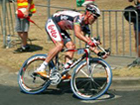Low back from constant flexion; neck - extensors, sternocleomastoid ; shoulders- pectoralis, trapezius, arms, wrists, hands from weight bearing on handle bars, quadriceps, hamstrings, gluteals, gastrocnemius. Overuse of the hamstrings is common as they are in a constant shortened position. Wrist strain may occur from clenched fists and flexor contraction.
Most bicycles on the market like racing bikes, road bikes and mountain bikes force the body to constantly lean the weight forward. The forward-bent position may be slightly more efficient for riding speed, but places tremendous stress on the low back, neck, shoulders, elbows and especially the wrists.
In the forward-bent position, continual tension is placed on the muscles, tendons, joints and supporting ligaments from the hands through the shoulders and into the back. Because these structures are under tension, bumps in the road send shocks of stress through the elbows, the shoulders and the very sensitive wrist ligaments and joints, making all of these areas more vulnerable to injury. Furthermore, the head, one of the heaviest parts of the body, is held up with the neck in extension for long periods of time, fatiguing the muscles of the neck and reducing the circulation and nerve impulses down the arms in many individuals. The low-back ligaments are also in a constantly stretched position, which makes them more vulnerable to damage by sudden additional forces. As are the wrist joints and their surrounding ligaments.
Mountain biking in this position makes the person especially vulnerable to injury because of the uneven, rough terrain that is navigated. Sudden wrist sprains may occur merely as a result of hitting several bumps in the road.
Many cycling injuries are associated with muscle imbalances that develop as a result of spending a lot of time pedalling and maintaining a hunched cycling posture. It's especially important to stretch your hamstrings, hips and lower back, and to strengthen all of the core muscles . Perhaps the most underappreciated cause of overuse injuries in repetitive-motion sports is technique errors. Because sports like cycling involve extreme repetition of a single movement, even a small deviation from correct form in that movement can result in a debilitating degree of tissue damage over time.
When cycling, extended periods of time are spent with your head cocked into extension so that you can see the road. This requirement often results in chronic loading of the short extensor muscles of the neck and is associated with an exaggerated cervical curvature and encourages forward head posture. Cyclists are notorious for having an increased thoracic kyphosis from cycling in a seated position with a rounded upper back.
To improve posture and counterbalance the sport-specific muscle and postural imbalances created by the cycling leg, you will find doing exercises that work the extensors of the spine to address the imbalance. However, before you perform these corrective exercises, it is a good idea to first stretch the pectoralis minor muscle The pec minor tends to be a workaholic in that it is easily shortened, tends to take over for other synergist muscles and inhibits antagonistic stabilizer muscles. By stretching this muscle first, you will be more likely to get a balancing effect from the corrective exercises.
As a cyclist you need a form of massage specifically designed for cyclists. Adding sports massage to your workout routine can improve your performance. As the training and hours pile up, so do the aches and pains. These little aches and pains can turn into a serious injury. Regular Sports Massage will help alleviate pain.
After a strenuous workout or race, sports massage will aid your recovery.
You can benefit from half an hour of work on a specific area that you feel needs attention or longer for more general and maintenance work.
Cyclists around the world rely on massage as an important part of their training regimen. Sports Massage techniques, when used regularly, can increase the blood flow that is needed for recovery. Also, it will improve the range of motion and strength of injured muscles and accelerate their healing process. With a full recovery you will be able to increase your workouts and allow your body to adapt to a higher level of stress.
Call today : 086 076 4307
From NI : 00353 86 076 4307
Email : charlie@ptclinic.ie |

